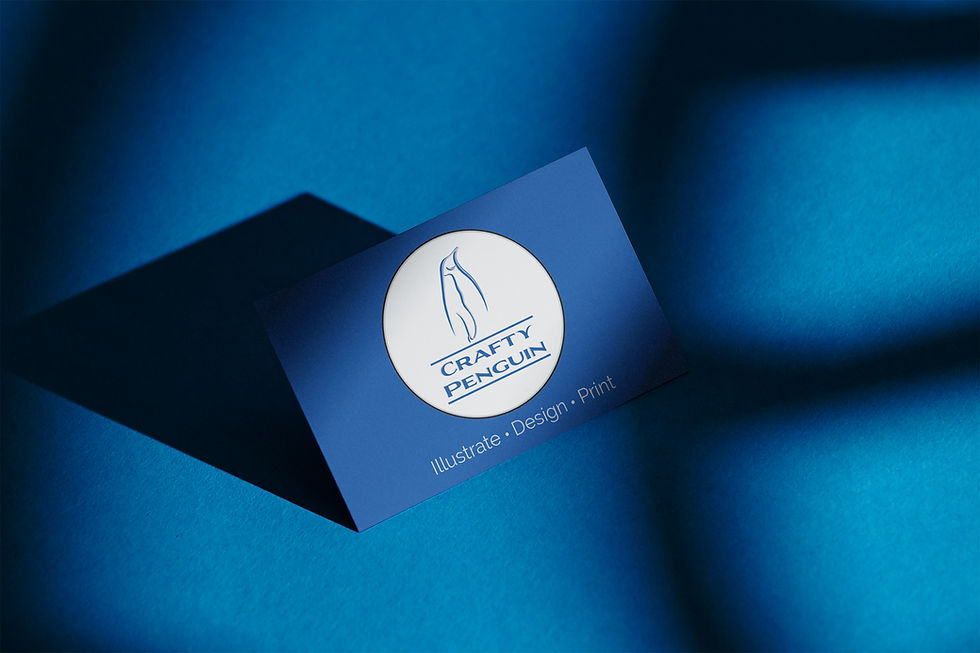How to Start Your Journey as a Graphic Designer | Crafty Penguin
- Crafty Penguin

- May 2
- 3 min read
Updated: May 18

Starting a career in graphic design can be incredibly rewarding, especially if you have a passion for creativity, problem-solving, and visual storytelling. As a graphic designer with years of experience in branding, illustration, and digital design, I understand the challenges and opportunities that come with breaking into the industry. If you're eager to learn how to start your journey as a graphic designer, here are some practical steps to help you get started.

1. Develop Your Core Graphic Design Skills
Graphic design is a balance of creativity and technical skills. To build a solid foundation, start by mastering key design principles, including:
Typography: Learn how to use fonts effectively.
Colour theory: Understand colour psychology and palettes.
Layout and composition: Organise design elements for visual harmony.
Visual hierarchy: Guide viewers' attention to the most important parts of your design.
Branding principles: Create designs that are consistent with brand identity.
There are many online resources available for learning these concepts, from free tutorials on YouTube to more in-depth courses on platforms like Skillshare, Udemy, and LinkedIn Learning. These resources will help you grasp the essential skills needed for any design project.

2. Master Graphic Design Software
To bring your ideas to life, you'll need to become proficient in design software. The most widely used tools in the graphic design industry is Adobe Creative Suite (Photoshop, Illustrator, and InDesign). Learning these tools will enable you to create everything from digital illustrations to branding elements, such as logos and marketing materials.
Additionally, experiment with other design tools, such as Canva, for quick designs. By mastering these tools, you will be ready to tackle a variety of design projects.

3. Build a Strong Online Portfolio
A portfolio is an essential tool for showcasing your design skills and attracting potential clients. Your portfolio should highlight your strengths and include a range of projects that demonstrate your versatility. On my portfolio page at craftypenguin.co.uk/portfolio, I feature examples of my work, from branding and digital illustrations to custom designs for businesses.
For example, my work with Get Lucky Apparel involved designing engaging visual content that reflected the brand’s personality, while my projects for One Stitches Three and the Bakewell Old House Museum showcased my ability to create promotional materials tailored for different industries. These projects allowed me to apply both my marketing knowledge and design skills to achieve impactful results.
You can also showcase your work on your own website or online portfolio to further expand your reach and connect with potential clients or collaborators.

4. Gain Real-World Experience
To gain practical experience, start with freelance projects, internships, or even personal creative ventures. By combining design knowledge with business expertise, Crafty Penguin offers custom-designed products like printed mugs, stickers, and personalised gifts. These projects not only helped me refine my design skills but also provided valuable client interactions that allowed me to grow my business and improve my portfolio.

5. Understand the Business Side of Graphic Design
Success in graphic design isn’t just about creativity, it’s also about effectively managing projects, communicating with clients, and setting fair prices for your work. Learn how to quote, invoice, and manage design projects so that you can run your design business smoothly and maintain strong relationships with your clients.

6. Network and Promote Yourself
Building connections within the design community and promoting your work online can open up new opportunities. Attend design events, engage with designers on social media platforms, and make sure to showcase your work on your own website. LinkedIn is also a great platform for sharing your journey and connecting with potential clients or employers.

7. Stay Committed to Continuous Learning
The world of graphic design is always evolving. To remain competitive, it's crucial to stay up to date with the latest trends, software updates, and design techniques. I continually enhance my skills by attending industry events, completing online courses, and experimenting with new tools to ensure that my designs remain fresh, creative, and relevant.
Final Thoughts: Starting Your Career in Graphic Design
Becoming a successful graphic designer requires dedication, creativity, and persistence. By mastering the fundamentals, building a strong portfolio, gaining hands-on experience, and staying on top of industry trends, you can carve out a fulfilling career in graphic design. If you'd like to see examples of my work or collaborate on a design project, visit my portfolio at craftypenguin.co.uk/portfolio.
Starting your journey as a graphic designer can feel overwhelming, but with determination and the right approach, you'll find success. Best of luck in your creative journey.
Louise Cranstone-Spooner








Comments